2.1 Areas between Curves
Learning Objectives
- Determine the area of a region between two curves by integrating with respect to
 .
. - Find the area of a compound region.
- Determine the area of a region between two curves by integrating with respect to
 .
.
In Introduction to Integration, we developed the concept of the definite integral to calculate the area below a curve on a given interval. In this section, we expand that idea to calculate the area of more complex regions. We start by finding the area between two curves defined by the functions of ![]() beginning with the simple case in which one function is always greater than the other. We then look at cases when the graphs of the functions intersect. Finally, we consider how to calculate the area between two curves whose equations express
beginning with the simple case in which one function is always greater than the other. We then look at cases when the graphs of the functions intersect. Finally, we consider how to calculate the area between two curves whose equations express ![]() as a function of
as a function of ![]()
Area of a Region between Two Curves
Let ![]() and
and ![]() be continuous functions over an interval
be continuous functions over an interval ![]() such that
such that ![]() on
on ![]() We want to find the area between the graphs of the functions, as shown in the following figure.
We want to find the area between the graphs of the functions, as shown in the following figure.

 and
and  on the interval
on the interval ![Rendered by QuickLaTeX.com \ds \left[a,b\right].](https://pressbooks.openedmb.ca/app/uploads/quicklatex/quicklatex.com-a79a232b9ebb8c1a0d37b37f5eb44d1b_l3.png)
As we did before, we are going to partition the interval on the ![]() and approximate the area between the graphs of the functions with rectangles. So, for
and approximate the area between the graphs of the functions with rectangles. So, for ![]() let
let ![]() be a regular partition of
be a regular partition of ![]() Then, for
Then, for ![]() choose a point
choose a point ![]() and on each interval
and on each interval ![]() construct a rectangle that extends vertically from
construct a rectangle that extends vertically from ![]() to
to ![]() Figure (a) shows the rectangles when
Figure (a) shows the rectangles when ![]() is selected to be the left endpoint of the interval and
is selected to be the left endpoint of the interval and ![]() Figure (b) shows a representative rectangle in detail.
Figure (b) shows a representative rectangle in detail.

 and
and  with rectangles. (b) The area of a typical rectangle goes from one curve to the other.
with rectangles. (b) The area of a typical rectangle goes from one curve to the other.The height of each individual rectangle is ![]() and the width of each rectangle is
and the width of each rectangle is ![]() Adding the areas of all the rectangles, we see that the area between the curves is approximated by
Adding the areas of all the rectangles, we see that the area between the curves is approximated by
This is a Riemann sum, so when we take the limit as ![]() , we get
, we get
![Rendered by QuickLaTeX.com \ds A=\underset{n\to \infty }{\text{lim}}\underset{i=1}{\overset{n}{\sum}}\left[f({x}_{i}^{*})-g({x}_{i}^{*})\right]\Delta x=\int\limits_{a}^{b}\left[f(x)-g(x)\right]\,dx .](https://pressbooks.openedmb.ca/app/uploads/quicklatex/quicklatex.com-f0f48ce1413c86102b93ac65fe92cd6d_l3.png)
These findings are summarized in the following theorem.
Finding the Area between Two Curves
Let ![]() and
and ![]() be continuous functions such that
be continuous functions such that ![]() over an interval
over an interval ![]() Let
Let ![]() denote the region bounded above by the graph of
denote the region bounded above by the graph of ![]() below by the graph of
below by the graph of ![]() and on the left and right by the lines
and on the left and right by the lines ![]() and
and ![]() respectively. Then, the area of
respectively. Then, the area of ![]() is given by
is given by
![Rendered by QuickLaTeX.com \ds A=\int\limits_{a}^{b}\left[f(x)-g(x)\right]\,dx .](https://pressbooks.openedmb.ca/app/uploads/quicklatex/quicklatex.com-dee2e2249383d05f971cb2c083684716_l3.png)
We apply this theorem in the following example.
Finding the Area of a Region between Two Curves 1
If R is the region bounded above by the graph of the function ![]() and below by the graph of the function
and below by the graph of the function ![]() over the interval
over the interval ![]() find the area of region
find the area of region ![]()
Solution
The region is depicted in the following figure.
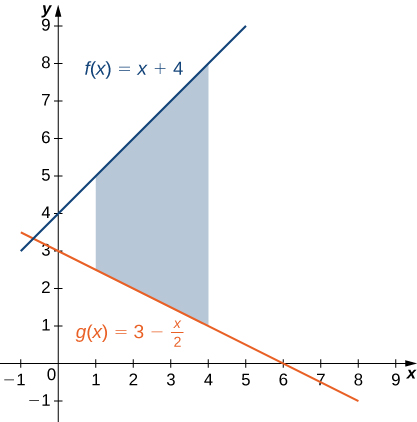
We have
![Rendered by QuickLaTeX.com \ds \begin{array}{cc}\ds \hfill A&\ds =\int\limits_{a}^{b}\left[f(x)-g(x)\right]\,dx \hfill \\[5mm] &\ds =\int\limits_{1}^{4}\left[(x+4)-(3-\frac{x}{2})\right]\,dx =\int\limits_{1}^{4}\left[\frac{3x}{2}+1\right]\,dx \hfill \\[5mm] &\ds ={\left[\frac{3{x}^{2}}{4}+x\right]}\Big|_{1}^{4}=(16-\frac{7}{4})=\frac{57}{4}.\hfill \end{array}](https://pressbooks.openedmb.ca/app/uploads/quicklatex/quicklatex.com-6361cf5fe1f864dfbd78e4091972cbae_l3.png)
The area of the region is ![]()
If ![]() is the region bounded by the graphs of the functions
is the region bounded by the graphs of the functions ![]() and
and ![]() over the interval
over the interval ![]() find the area of region
find the area of region ![]()
Answer
12 units 2
In the above examples, we defined the interval of interest as part of the problem statement. Quite often, though, we want to define our interval of interest based on where the graphs of the two functions intersect. This is illustrated in the following example.
Finding the Area of a Region between Two Curves 2
If ![]() is the region bounded above by the graph of the function
is the region bounded above by the graph of the function ![]() and below by the graph of the function
and below by the graph of the function ![]() find the area of
find the area of ![]()
Solution
The region is depicted in the following figure.

 and above the graph of
and above the graph of 
We first need to compute where the graphs of the functions intersect. Setting ![]() we get
we get
![Rendered by QuickLaTeX.com \ds \begin{array}{ccc}\hfill f(x)&\ds =\hfill &\ds g(x)\hfill \\[2mm] \ds \hfill 9-{\left(\frac{x}{2}\right)}^{2}&\ds =\hfill &\ds 6-x\hfill \\[3mm] \ds \hfill 9-\frac{{x}^{2}}{4}&\ds =\hfill &\ds 6-x\hfill \\[3mm] \ds \hfill 36-{x}^{2}&\ds =\hfill &\ds 24-4x\hfill \\[2mm] \ds \hfill {x}^{2}-4x-12&\ds =\hfill &\ds 0\hfill \\[2mm] \ds \hfill (x-6)(x+2)&\ds =\hfill &\ds 0.\hfill \end{array}](https://pressbooks.openedmb.ca/app/uploads/quicklatex/quicklatex.com-5aba24b79e14937b190631eb5c437a2c_l3.png)
The graphs of the functions intersect when ![]() or
or ![]() so we want to integrate from -2 to 6. Since
so we want to integrate from -2 to 6. Since ![]() for
for ![]() we obtain
we obtain
![Rendered by QuickLaTeX.com \ds \begin{array}{cc}\ds \hfill A&\ds =\int\limits_{a}^{b}\left[f(x)-g(x)\right]\,dx \hfill \\[5mm] &\ds =\int\limits_{-2}^{6}\left[9-{(\frac{x}{2})}^{2}-(6-x)\right]\,dx =\int\limits_{-2}^{6}\left[3-\frac{{x}^{2}}{4}+x\right]\,dx \hfill \\[5mm] &\ds ={\left[3x-\frac{{x}^{3}}{12}+\frac{{x}^{2}}{2}\right]}\Big|_{-2}^{6}=\frac{64}{3}.\hfill \end{array}](https://pressbooks.openedmb.ca/app/uploads/quicklatex/quicklatex.com-4731385b130ba4681c2db5e744fc4845_l3.png)
The area of the region is ![]() units 2 .
units 2 .
If R is the region bounded above by the graph of the function ![]() and below by the graph of the function
and below by the graph of the function ![]() find the area of region
find the area of region ![]()
Answer
![]() unit 2
unit 2
Areas of Compound Regions
So far, we have required ![]() over the entire interval of interest, but what if we want to look at regions bounded by the graphs of functions that cross one another? In that case, we modify the process we just developed by using the absolute value function.
over the entire interval of interest, but what if we want to look at regions bounded by the graphs of functions that cross one another? In that case, we modify the process we just developed by using the absolute value function.
Finding the Area of a Region between Intersecting Curves
Let ![]() and
and ![]() be continuous functions over an interval
be continuous functions over an interval ![]() Let
Let ![]() denote the region between the graphs of
denote the region between the graphs of ![]() and
and ![]() and be bounded on the left and right by the lines
and be bounded on the left and right by the lines ![]() and
and ![]() respectively. Then, the area of
respectively. Then, the area of ![]() is given by
is given by

In practice, applying this theorem requires us to break up the interval ![]() and evaluate several integrals, depending on which of the function values is greater over a given part of the interval. We study this process in the following example.
and evaluate several integrals, depending on which of the function values is greater over a given part of the interval. We study this process in the following example.
Finding the Area of a Region Bounded by Intersecting Curves
If R is the region between the graphs of the functions ![]() and
and ![]() over the interval
over the interval ![]() find the area of region
find the area of region ![]()
Solution
The region is depicted in the following figure.
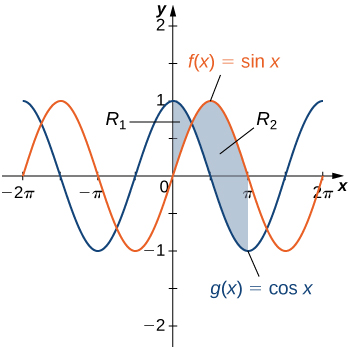
The graphs of the functions intersect at ![]() For
For ![]()
![]() so
so
On the other hand, for ![]()
![]() so
so
Then
![Rendered by QuickLaTeX.com \ds \begin{array}{cc}\ds \hfill A&\ds =\int\limits_{a}^{b}|f(x)-g(x)|\,dx \hfill \\[5mm] &\ds =\int\limits_{0}^{\pi }| \sin (x)- \cos (x)|\,dx =\int\limits_{0}^{\pi \text{/}4}( \cos (x)- \sin (x))\,dx +\int\limits_{\pi \text{/}4}^{\pi }( \sin (x)- \cos (x))\,dx \hfill \\[5mm] &\ds ={\left[ \sin (x)+ \cos (x)\right]}\Big|_{0}^{\pi \text{/}4}+{\left[- \cos (x)- \sin (x)\right]}\Big|_{\pi \text{/}4}^{\pi }\hfill \\[5mm] &\ds =(\sqrt{2}-1)+(1+\sqrt{2})=2\sqrt{2}.\hfill \end{array}](https://pressbooks.openedmb.ca/app/uploads/quicklatex/quicklatex.com-d28206e1635cd6727d1b725f6ec294af_l3.png)
The area of the region is ![]() units 2 .
units 2 .
If R is the region between the graphs of the functions ![]() and
and ![]() over the interval
over the interval ![]() find the area of region
find the area of region ![]()
Answer
![]() units 2
units 2
Hint
The two curves intersect at ![]()
Finding the Area of a Complex Region
Consider the region depicted in the Figure 6 below. Find the area of ![]()

Solution
As in the previous example, we need to divide the interval into two pieces. The graphs of the functions intersect at ![]() (set
(set ![]() and solve for
and solve for ![]() ), so we evaluate two separate integrals: one over the interval
), so we evaluate two separate integrals: one over the interval ![]() and one over the interval
and one over the interval ![]()
Over the interval ![]() the region is bounded above by
the region is bounded above by ![]() and below by the
and below by the ![]() -axis, so we have
-axis, so we have

Over the interval ![]() the region is bounded above by
the region is bounded above by ![]() and below by the
and below by the ![]() so we have
so we have
![Rendered by QuickLaTeX.com \ds {A}_{2}=\int\limits_{1}^{2}(2-x)\,dx ={\left[2x-\frac{{x}^{2}}{2}\right]}\Big|_{1}^{2}=\frac{1}{2}.](https://pressbooks.openedmb.ca/app/uploads/quicklatex/quicklatex.com-7f82dc54aa9196b5fcbdbfe5f8dd9409_l3.png)
Adding these areas together, we obtain
The area of the region is ![]() units 2 .
units 2 .
Consider the region depicted in the following figure. Find the area of ![]()

Answer
![]() units 2
units 2
Hint
The two curves intersect at ![]()
Regions Defined with Respect to y
In the previous examples, we had to evaluate two separate integrals to calculate the area of the region. However, there is another approach that requires only one integral. The idea is to rewrite the equations of the curves expressing ![]() as a functions of
as a functions of ![]() Going back to Figure 6, we note that the left graph, shown in red, is represented by the function
Going back to Figure 6, we note that the left graph, shown in red, is represented by the function ![]() We could just as easily solve this for
We could just as easily solve this for ![]() and represent the curve by the function
and represent the curve by the function ![]() (Note that
(Note that ![]() is also a valid representation of the function
is also a valid representation of the function ![]() as a function of
as a function of ![]() However, based on the graph, it is clear we are interested in the positive square root.) Similarly, the right graph is represented by the function
However, based on the graph, it is clear we are interested in the positive square root.) Similarly, the right graph is represented by the function ![]() but could just as easily be represented by the function
but could just as easily be represented by the function ![]() When the graphs are represented as functions of
When the graphs are represented as functions of ![]() we see the region is bounded on the left by the graph of one function and on the right by the graph of the other function. Therefore, if we integrate with respect to
we see the region is bounded on the left by the graph of one function and on the right by the graph of the other function. Therefore, if we integrate with respect to ![]() we need to evaluate one integral only. Let’s develop a formula for this type of integration.
we need to evaluate one integral only. Let’s develop a formula for this type of integration.
Let ![]() and
and ![]() be continuous functions over an interval
be continuous functions over an interval ![]() such that
such that ![]() for all
for all ![]() We want to find the area between the graphs of the functions, as shown in the following figure.
We want to find the area between the graphs of the functions, as shown in the following figure.

 and
and 
This time, we are going to partition the interval on the ![]() and use horizontal rectangles to approximate the area between the functions. So, for
and use horizontal rectangles to approximate the area between the functions. So, for ![]() let
let ![]() be a regular partition of
be a regular partition of ![]() Then, for
Then, for ![]() choose a point
choose a point ![]() then over each interval
then over each interval ![]() construct a rectangle that extends horizontally from
construct a rectangle that extends horizontally from ![]() to
to ![]() Figure (a) below shows the rectangles when
Figure (a) below shows the rectangles when ![]() is selected to be the lower endpoint of the interval and
is selected to be the lower endpoint of the interval and ![]() Figure (b) shows a representative rectangle in detail.
Figure (b) shows a representative rectangle in detail.

 and
and  with rectangles. (b) The area of a typical rectangle.
with rectangles. (b) The area of a typical rectangle.The height of each individual rectangle is ![]() and the width of each rectangle is
and the width of each rectangle is ![]() Therefore, the area between the curves is approximately
Therefore, the area between the curves is approximately
This is a Riemann sum, so we take the limit as ![]() obtaining
obtaining
![Rendered by QuickLaTeX.com \ds A=\underset{n\to \infty }{\text{lim}}\underset{i=1}{\overset{n}{\sum}}\left[u({y}_{i}^{*})-v({y}_{i}^{*})\right]\Delta y=\int\limits_{c}^{d}\left[u(y)-v(y)\right]dy.](https://pressbooks.openedmb.ca/app/uploads/quicklatex/quicklatex.com-5384b96f70e1e3e5c03bd9dde65a1cab_l3.png)
These findings are summarized in the following theorem.
Finding the Area between Two Curves, Integrating along the y-axis
Let ![]() and
and ![]() be continuous functions such that
be continuous functions such that ![]() for all
for all ![]() Let
Let ![]() denote the region bounded on the right by the graph of
denote the region bounded on the right by the graph of ![]() on the left by the graph of
on the left by the graph of ![]() and above and below by the lines
and above and below by the lines ![]() and
and ![]() respectively. Then, the area of
respectively. Then, the area of ![]() is given by
is given by
![Rendered by QuickLaTeX.com \ds A=\int\limits_{c}^{d}\left[u(y)-v(y)\right]dy.](https://pressbooks.openedmb.ca/app/uploads/quicklatex/quicklatex.com-6adc28470707d0438da100194d2dbb78_l3.png)
Integrating with Respect to y
Let’s revisit the example with the region shown in Figure 6, only this time let’s integrate with respect to ![]() Let
Let ![]() be the region depicted in below. Find the area of
be the region depicted in below. Find the area of ![]() by integrating with respect to
by integrating with respect to ![]()

 can be calculated using one integral only when the curves are treated as functions of
can be calculated using one integral only when the curves are treated as functions of 
Solution
We must first express the graphs as functions of ![]() As we saw at the beginning of this section, the curve on the left can be represented by the function
As we saw at the beginning of this section, the curve on the left can be represented by the function ![]() and the curve on the right can be represented by the function
and the curve on the right can be represented by the function ![]()
Now we have to determine the limits of integration. The region is bounded below by the ![]() -axis, so the lower limit of integration is
-axis, so the lower limit of integration is ![]() The upper limit of integration is determined by the point where the two graphs intersect, which is the point
The upper limit of integration is determined by the point where the two graphs intersect, which is the point ![]() so the upper limit of integration is
so the upper limit of integration is ![]() Thus, we have
Thus, we have ![]()
Calculating the area of the region, we get
![Rendered by QuickLaTeX.com \ds \begin{array}{cc}\ds \hfill A&\ds =\int\limits_{c}^{d}\left[u(y)-v(y)\right]dy\hfill \\[5mm] &\ds =\int\limits_{0}^{1}\left[(2-y)-\sqrt{y}\right]dy={\left[2y-\frac{{y}^{2}}{2}-\frac{2}{3}{y}^{3\text{/}2}\right]}\Big|_{0}^{1}\hfill \\[5mm] &\ds =\frac{5}{6}.\hfill \end{array}](https://pressbooks.openedmb.ca/app/uploads/quicklatex/quicklatex.com-7331cfb426b21ecc49a7fac767162e70_l3.png)
The area of the region is ![]() units 2 .
units 2 .
Let’s revisit the exercise associated with Figure 7, only this time, let’s integrate with respect to ![]() Let be the region depicted in the following figure. Find the area of
Let be the region depicted in the following figure. Find the area of ![]() by integrating with respect to
by integrating with respect to ![]()

Answer
![]() units 2
units 2
Hint
Follow the process from the previous example.
Key Concepts
- Just as definite integrals can be used to find the area under a curve, they can also be used to find the area between two curves.
- To find the area between two curves defined by functions, integrate the difference of the functions.
- If the graphs of the functions cross, or if the region is complex, use the absolute value of the difference of the functions. In this case, it may be necessary to evaluate two or more integrals and add the results to find the area of the region.
- Sometimes it can be easier to integrate with respect to
 to find the area. The principles are the same regardless of which variable is used as the variable of integration.
to find the area. The principles are the same regardless of which variable is used as the variable of integration.
Key Equations
- Area between two curves, integrating on the
 -axis
-axis
![Rendered by QuickLaTeX.com \ds A=\int\limits_{a}^{b}\left[f(x)-g(x)\right]\,dx](https://pressbooks.openedmb.ca/app/uploads/quicklatex/quicklatex.com-ab5c36ba45cd1357121936d05571408f_l3.png)
- Area between two curves, integrating on the
 -axis
-axis
![Rendered by QuickLaTeX.com \ds A=\int\limits_{c}^{d}\left[u(y)-v(y)\right]dy](https://pressbooks.openedmb.ca/app/uploads/quicklatex/quicklatex.com-df7899a5f4651c05a3fc0d3c008a14d1_l3.png)
Exercises
For the following exercises, determine the area of the region between the two curves in the given figure by integrating over the ![]()
1. ![]()
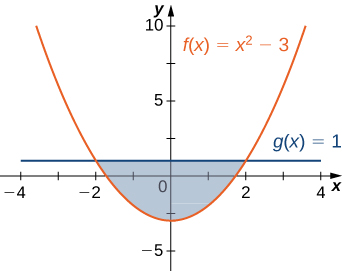
Answer
![]()
2. ![]()
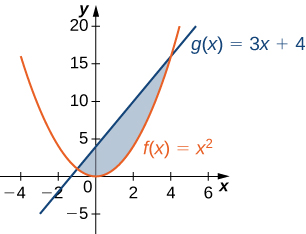
For the following exercises, split the region between the two curves into two smaller regions, then determine the area by integrating over the ![]() Note that you will have two integrals to evaluate.
Note that you will have two integrals to evaluate.
3. ![]() and
and ![]()

Answer
![]()
4. ![]() and
and ![]() for
for ![]()
For the following exercises, determine the area of the region between the two curves by integrating over the ![]()
5. ![]()

Answer
36
6. ![]()
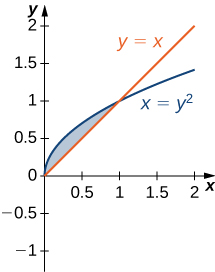
For the following exercises, graph the equations and shade the area of the region between the curves. Determine its area by integrating over the ![]()
7. ![]()
Answer
 243 square units
243 square units
8. ![]()
9. ![]() and
and ![]() on
on ![]() (Hint: use that
(Hint: use that ![]() to sketch the curve.)
to sketch the curve.)
Answer
 4
4
10. ![]()
11. ![]()
Answer

![]()
12. ![]()
13. ![]()
Answer

![]()
For the following exercises, graph the equations and shade the area of the region between the curves. If necessary, break the region into sub-regions to determine its entire area.
14. ![]()
15. ![]()
Answer

![]()
16. ![]() and
and ![]() over
over ![]()
17. ![]() over
over ![]()
Answer

![]()
18. ![]() over
over ![]()
19. ![]() and
and ![]()
Answer

![]()
For the following exercises, graph the equations and shade the area of the region between the curves. Determine its area by integrating over the ![]() -axis.
-axis.
20. ![]()
21. ![]()
Answer

![]()
22. ![]()
23. ![]()
Answer

![]()
24. ![]()
25. ![]()
Answer

![]()
For the following exercises, graph the equations and shade the area of the region between the curves. Determine its area by integrating over the ![]() -axis or
-axis or ![]() -axis, whichever seems more convenient.
-axis, whichever seems more convenient.
26. ![]()
27.* ![]()
Answer

![]()
28. ![]()
29. ![]()
Answer
![]()
30. ![]()
31. ![]()
Answer

![]()
32. ![]()
33. ![]()
Answer

![]()
34. ![]()
35. ![]()
Answer

![]()
36. ![]()
37. ![]()
Answer
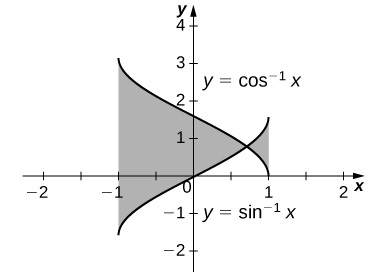
![]()
For the following exercises, find the exact area of the region bounded by the given equations if possible. If you are unable to determine the intersection points analytically, use a calculator to approximate the intersection points with three decimal places and determine the approximate area of the region.
38. [T] ![]()
39. [T] ![]()
Answer
1.067
40. [T] ![]()
41. [T] ![]()
Answer
1.605
42. [T] ![]()
43. [T] ![]()
Answer
7.523
44. [T] ![]()
45. [T] ![]()
Answer
![]()
46. [T] ![]()
47. [T] ![]()
Answer
1.429
48. The largest triangle with a base on the ![]() that fits inside the upper half of the unit circle
that fits inside the upper half of the unit circle ![]() is given by
is given by ![]() and
and ![]() See the following figure. What is the area inside the semicircle but outside the triangle?
See the following figure. What is the area inside the semicircle but outside the triangle?

49. A factory selling cell phones has a marginal cost function ![]() where
where ![]() represents the number of cell phones, and a marginal revenue function given by
represents the number of cell phones, and a marginal revenue function given by ![]() Find the area between the graphs of these curves and
Find the area between the graphs of these curves and ![]() What does this area represent?
What does this area represent?
Answer
![]() total profit for 200 cell phones sold
total profit for 200 cell phones sold
50. An amusement park has a marginal cost function ![]() where
where ![]() represents the number of tickets sold, and a marginal revenue function given by
represents the number of tickets sold, and a marginal revenue function given by ![]() Find the total profit generated when selling 550 tickets. Use a calculator to determine intersection points, if necessary, to two decimal places.
Find the total profit generated when selling 550 tickets. Use a calculator to determine intersection points, if necessary, to two decimal places.
51. The tortoise versus the hare: The speed of the hare is given by the sinusoidal function ![]() whereas the speed of the tortoise is
whereas the speed of the tortoise is ![]() where
where ![]() is time measured in hours and the speed is measured in miles per hour. Find the area between the curves from time
is time measured in hours and the speed is measured in miles per hour. Find the area between the curves from time ![]() to the first time after one hour when the tortoise and hare are traveling at the same speed. What does it represent? Use a calculator to determine the intersection points, if necessary, accurate to three decimal places.
to the first time after one hour when the tortoise and hare are traveling at the same speed. What does it represent? Use a calculator to determine the intersection points, if necessary, accurate to three decimal places.
Answer
3.263 mi represents how far ahead the hare is from the tortoise
52. The tortoise versus the hare: The speed of the hare is given by the sinusoidal function ![]() whereas the speed of the tortoise is
whereas the speed of the tortoise is ![]() where
where ![]() is time measured in hours and speed is measured in kilometers per hour. If the race is over in 1 hour, who won the race and by how much? Use a calculator to determine the intersection points, if necessary, accurate to three decimal places.
is time measured in hours and speed is measured in kilometers per hour. If the race is over in 1 hour, who won the race and by how much? Use a calculator to determine the intersection points, if necessary, accurate to three decimal places.
For the following exercises, find the area between the curves by integrating with respect to ![]() and then with respect to
and then with respect to ![]() Is one method easier than the other? Do you obtain the same answer?
Is one method easier than the other? Do you obtain the same answer?
53. ![]()
Answer
![]()
54. ![]()
55. ![]()
Answer
![]()
For the following exercises, solve using calculus, then check your answer with geometry.
56. Determine the equations for the sides of the square that touches the unit circle on all four sides, as seen in the following figure. Find the area between the perimeter of this square and the unit circle. Is there another way to solve this without using calculus?

57. Find the area between the perimeter of the unit circle and the triangle created from ![]() and
and ![]() as seen in the following figure. Is there a way to solve this without using calculus?
as seen in the following figure. Is there a way to solve this without using calculus?

Answer
![]()


Hint
Graph the functions to determine which function’s graph forms the upper bound and which forms the lower bound, then follow the process used in the previous example.